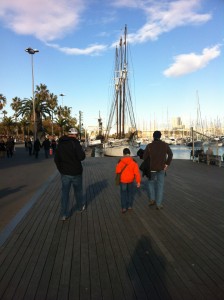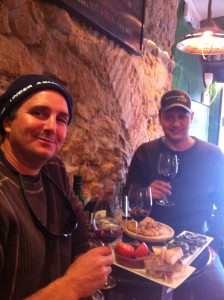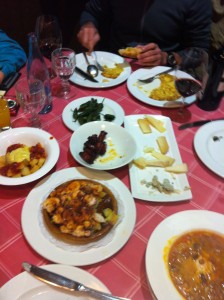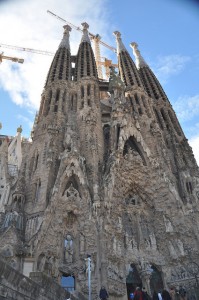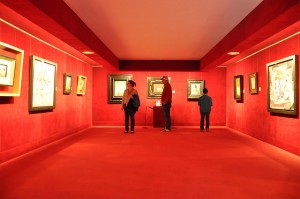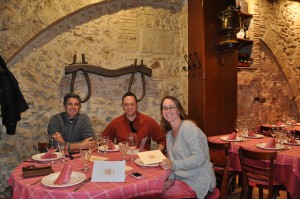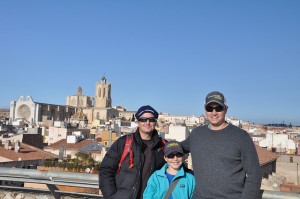It is not easy to meet up with friends and relatives on this trip. In fact, it can be ridiculously difficult if you don’t follow this cruising guideline: “You can pick the time. Or you can pick the place. But you can’t pick both.” It may not seem that difficult to coordinate meeting up, but it can be extremely difficult to get your boat to a certain location at an exact time. Weather, crew fatigue, boat repairs and prevailing conditions all contribute to how fast or slow we go. As another cruiser once told us, “the most dangerous piece of equipment on board a sailboat is a calendar.” We just don’t know where we are going to be and when we are going to be there. We make major changes all the time. Here are just a few examples:
- We hadn’t intended on cruising the Sea of Cortez when going down the coast of Mexico. However, when we got to Cabo San Lucas we decided we couldn’t *not* go so we spent a little over two weeks exploring part of that wonderful area. (Note: this was a woefully insignificant amount of time to explore the Sea of Cortez, but it gave us enough of a taste to know we want to come back. In fact, this whole trip seems like it’s been that way!)
- We had originally intended on going to the “ABC Islands” from Panama, and then make our way up the Lesser Antilles, but prevailing conditions meant we’d be beating to weather for thousands of miles, and the sea conditions in the vicinity of the Gulf of Venezula are notoriously rough. So we opted instead to beat to weather only 700 miles to Jamaica. We ended up missing the Lesser Antilles entirely.
- We had intended on crossing the Atlantic later than we actually did, but in conversations with our weather router (Commander’s Weather) we decided to bring in the shove off date by 6 weeks, which meant we had to cruise up the U.S. East Coast much faster than anticipated.
- When we made landfall in Europe, our original plan was to go as far East as possible (Greece, maybe Turkey) and then slowly make our way back. However, when we got to Lisbon the thought of going another 2,000 nautical miles in a short amount of time (in Winter) was not appealing (and we were exhausted) so we decided to slowly make our way East instead
We also make changes to our sailing plan on a daily, and sometimes hourly basis. For example:
- When we were cruising up the Intracoastal Waterway in North Carolina we were heading up to Manteo. We had been keeping an eye on a tropical depression that was forming off of Florida. As we were making our way up toward Manteo the tropical depression deepened and we decided to make our way more inland. During the day as we were monitoring the situation we decided instead to get as far West as possible and that led us up the Great Dismal Swamp toward Virginia. As the tropical depression turned into Hurricane Arthur, we were safely tied to a dock between two locks in the swamp. Later, when we got to Norfolk, Virginia, we rented a car to go see Kitty Hawk near Manteo.
We successfully met up with our friend Eric and two of his sons because he chose the time over the location. He purchased tickets into San Juan, Puerto Rico well in advance and his plan was to buy last-minute tickets to wherever we were in the Caribbean. (As it turns out, we were in San Juan, Puerto Rico but only made there just in time…)
So we were thrilled when we were able to meet up with Darold’s brother, John, while in Barcelona. We took a risk and chose the place *and* the time. He was going to be in Europe on a business trip and we took an educated guess that we’d be in Barcelona at the time he was there. Our plans actually changed after he purchased his tickets (we decided not to go to the Balearic Islands due to weather) and we thought we’d be up in Barcelona sooner than originally planned, but then we decided to stay longer in Cartagena so that we ended up arriving in Barcelona when originally planned. Sometimes things just work out.
So, after spending several weeks anchoring up the Spanish coast, we arrived in Badalona, which is a city on the northern outskirts of Barcelona. We had just enough time to make a few repairs, get the boat cleaned up, do laundry and get provisioned up, rent a car to take a side trip to Madrid, and then pick up John from the Barcelona airport.
After we picked up John, we went directly to Tarragona, an old Spanish city with amazing Roman ruins and also a beautiful medieval church. The Roman ruins are so in-tact and extensive that the city is named a UNESCO World Heritage site. There is a coliseum, a circus maximus, old city walls and more. It was pretty impressive. You can walk down the underground tunnel of the circus maximus, come out of a doorway and imagine chariots racing by. It is also an extremely charming city today.
After exploring the ruins we went in search of food and happened upon the perfect place for tapas and wine. It looked like it was inside a little cave. They made us a delicious spread of tapas and we chose a delicious wine (from their extensive selection) from the North of Spain. It was perfect.
The following day we drove up to Figueras, which is about an hour and half north of Barcelona and is host to the Salvador Dali Museum. Dali was born in Figueras and when the city asked him to donate a piece of his art to their collection, he said he’d do one better and build a museum to house a whole collection of his art. The museum looks very Dali-esque with giant eggs on the top of the building. Some of the rooms inside the museum are entire art exhibits. In the largest room you can see a painting of a naked women made with individually painted tiles. But when you look at the painting through a telescope it is Abraham Lincoln. So very Dali. Dali is actually buried in the building in a mausoleum below the main room. Before touring the museum we had another delicious Spanish meal of a variety of tapas (with wine of course).
I can’t go on without talking more about Spanish food. If you’ve never had Spanish food, a common misconception is that it is like Mexican food. The only foods that are similar are gazpacho (cold tomato-based soup), flan (custard pudding) and churros (fried dough). If you ordered “tortilla” in Spain, you’d get something that was completely different from a Mexican tortilla. Here’s a primer on some of the foods we had while John toured around Barcelona with us:
- Foods:
- Pimientos de Padron – these are small green peppers that are roasted and then salted. You pick them up by the stem and eat the pepper
- Patatas Bravas – small chunks of potato that are twice fried and served with a sauce on top of it that is a cross between an aioli and a tomato sauce. Sometimes they say the sauce is “muy brava,” meaning that it is very hot. However, it is not hot to folks who are used to Mexican food. Spanish food is not spicy!
- Tortilla Espanola – this is a dish of potatoes held together with eggs in the shape of a sautee pan. Sometimes they put onions in it, and sometimes they put things like green pappers or mushrooms or chorizo. However, it is most traditionally served just potatoes and eggs and it is served room temperature. They even put it inside a small roll as a sandwich.
- Jamon – The Spanish love their ham. It’s sort of like Italian prosciutto. It’s served in a bocadillo (a sandwich of jam in between a roll – that’s it) or slices of jamon on a plate. There are different grades of jamon, and you get a really expensive plate of high quality jamon or something less expensive that’s nearly just as good.
- Aceitunas – Spanish olives. The Spanish make excellent olives and olive oil. Manzanilla olives are delicious (usually what we think of as Spanish olives but without the pimimento inside). But more typical are anchovy-flavored olives or anchovy-stuffed olves (anchoa.) Don’t flinch! They are delicious. Also delicious are the arbequina olives – these are small olives with the pit inside.
- Croquettas – I love these things. They are béchamel sauce with jam or chicken or bacalao (cod) fried with bread crumbs on the outside. I like the bacalao ones the best. Absolutely delicious.
- Calamares – Fried calamari – the Spanish do a nice job of this. Sometimes they put it in a bocadillo (sandwich) which sounds like it would be too starchy, but it’s not.
- Olive oil – Spain is the largest producer of olive oil and they know how to make it.
- Seafood – the Spanish love canned seafood such as anchoas (anchovies) mussles (mejillones), or boquerones (white anchovies.) For some reason Americans have an aversion to these types of seafood, but the Spanish know how to serve them. Often these bits of seafood are served on top of a little slice of bread with other garnishes
- Pan con tomate – You can order a plate of bread with tomato. Sometimes the bread is toasted and they’ll even put a clove of garlic on the plate for you to rub on the bread. Sometimes the bread is already rubbed with the tomato. It’s great to dip in olive oil.
- Paella – of course there’s paella, the famous Spanish rice dish. It’s actually from Valencia so if you order it anywhere outside of that region it’s not considered “real” paella, but who cares. In my high school Spanish class I learned that it was a dish made for the queen “para ella” (for her). It is typically cooked with seafood but you can get it in a variety of styles.
- Marcona almonds – these are almonds that have the skin off, and I believe they are fried and then salted.
- Pulpo – Octopus! I like “Pulpo a la gallega” which is broiled octopus with pimento.
- Churros con chocolate – If you are ever in Spain you must, must, must try the churros con chocolate. Chocolate is their hot chocolate, which is about 1,000 times thicker than American hot chocolate. It’s like drinking a really good melted chocolate bar. The churros are similar to Mexican churros but smaller and not usually covered in sugar. They also serve porras, which are similar to churros but larger.
- Palmeras con chocolate – I love palmeras, which are “palm leaf” pastry, covered in chocolate. The Spanish also have a variety of other delicious pastries. If you are ever in a Pasteleria, just point at what looks good and you can’t go wrong.
- Wikipedia does a nice summary of Spanish tapas here: http://en.wikipedia.org/wiki/Tapash
- Drinks
- Rioja – Spanish wine that is delicious. In fact, all wine we tried in Spain was good. From the 5 Euro bottles in the grocery story to the 20 Euro bottles at the restaurant. The Spanish make good wine.
- Sangria – This is Spanish wine steeped with fruit and with a little sugar and brandy added
- Tinto de Verano – “Color of Summer” – This is one of my favorite Spanish drinks. It is Spanish wine cut with “La Casera” which is Spain’s version of 7-Up. It’s best when it’s hot outside.
- Jerez (sherry) – If you get an aged jerez, it’s delicious and akin to Portuguese port.
- Cava – this is Spanish champagne. It’s cheap and it’s good.
- Beer (a cana) – When you order a beer in Spain you order it usually by the size, and a “cana” (with a tilde over the n) is a medium-sized beer (maybe 6 ounces). Spanish beer is generally pretty good.
- For some reason, gin and tonics are really popular in Spain right now. We saw so many people drinking them and several bartenders told us that they were very “in fashion.” They seem to love Hendrick’s gin (not Spanish, but delicious!) and then will add a slice of cucumber, or a few juniper berries to the drink. Try it, you will like it.
Suddenly, I’m really hungry.
Anyway, after driving back to Barcelona from Figueras, we took the Metro into downtown Barcelona for a few drinks (in the Placa Reial, the city’s main plaza) and to walk around. Barcelona must be the most touristy city we’ve been to in Spain because walking down “Las Ramblas” (the main walking thoroughfare) we were asked a dozen times (in English) if we wanted to dine at their restaurant, drink at their bar or enter their club. January is pretty chilly in Barcelona so we were definitely bundled up, though still feeling the cold creep into the crevasses of our clothing.
The next morning it was finally time to tour the city of Barcelona (during the day.) We intended on going inside the famous Sagrada Familia (Gaudi’s cathedral, still under construction since the 1800s!), but the line was around the block and it was 50 Euro to enter for all of us. Last time I was there it was free and there was no line. Oh well. So instead we walked around the building (and Dante recounted what he’d learned about the inside of it from a video he watched). Then we went and had coffee at the Palau de la Musica Catalana (a beautiful building) and afterwards walked toward Barcelona’s cathedral (La Catedral, Barcelona’s Gothic Cathedral), continued to stroll through the Barri Gotic (small, ancient alleyways) and toured around an amazing indoor market – Mercat de la Boqueria – full of mini stands selling tapas, meats, cheeses, pastries, candies, fish, and almost anything else you can imagine. We ended the day with more tapas (of course) at a restaurant near the cathedral.
There is a lot more to see in Barcelona that we didn’t have time to visit, including a Picasso Museum that’s supposed to be fantastic. Next time, I guess. It was an awesome three days, and even more so because we were with Uncle John.
